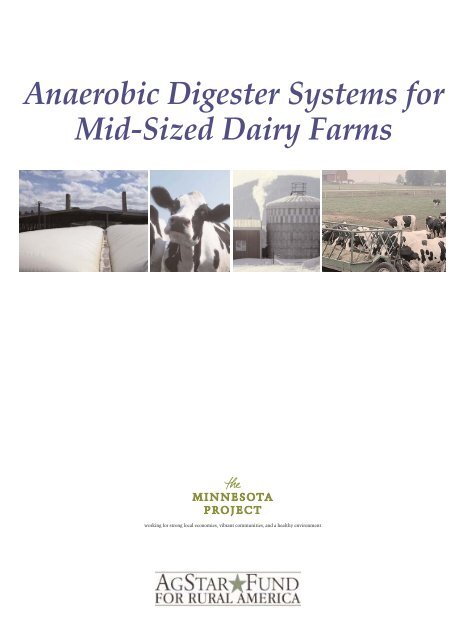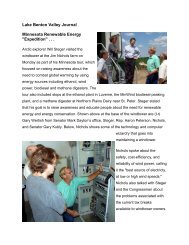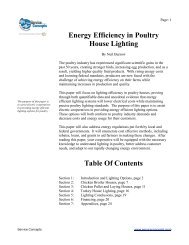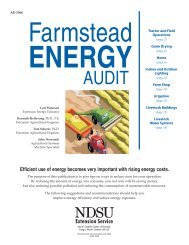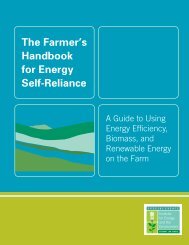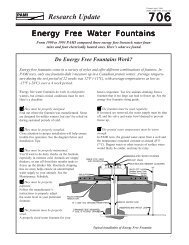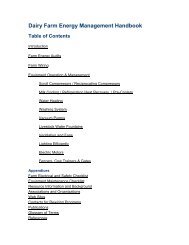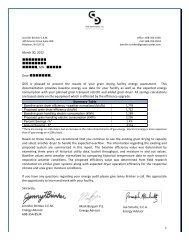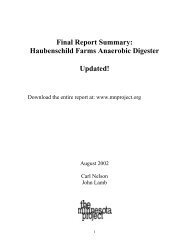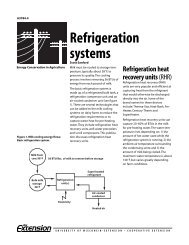Anaerobic Digester Systems for Mid-Sized Dairy Farms
Anaerobic Digester Systems for Mid-Sized Dairy Farms
Anaerobic Digester Systems for Mid-Sized Dairy Farms
Create successful ePaper yourself
Turn your PDF publications into a flip-book with our unique Google optimized e-Paper software.
<strong>Anaerobic</strong> <strong>Digester</strong> <strong>Systems</strong> <strong>for</strong><strong>Mid</strong>-<strong>Sized</strong> <strong>Dairy</strong> <strong>Farms</strong>
EXECUTIVE SUMMARYSix options <strong>for</strong> anaerobic digestion of animal manure on mid-sized dairy farms in Minnesotahave been presented to provide dairy farm operators with in<strong>for</strong>mation needed to makedecisions about odor control and manure management technology.In<strong>for</strong>mation <strong>for</strong> each option is presented with schematics of the system, an explanation ofhow the system functions, the environmental benefits and lessons learned from other similardigesters. Capital costs <strong>for</strong> the installation of the digesters and yearly costs are presented. Theexpected benefits from odor control and use of separated solids are presented <strong>for</strong> a 100-cowdairy. Scale up in<strong>for</strong>mation <strong>for</strong> 200-cow and 300-cow dairies are included as a multiplierfactor. There are also answers to the questions “who should consider a system like this?” and“why would a farmer install this digester?” Resources are provided with who to contact aboutsimilar digesters and additional references relevant to each design.The generation of energy is discussed in a separate section. The six options applied tomid-sized farms do not produce excess energy beyond the energy needed to heat the digesterduring the winter months. Adding capacity and electrical generators would be an upgrade tothe digester after experience was gained with the digestion system.Five options presented would be constructed on an individual farm. A sixth option proposesthat three to four neighbors within a two-mile radius construct and operate a communitydigester. This community digester includes both separation of solids <strong>for</strong> use as bedding and<strong>for</strong> off-farm sale to nurseries or as compost. An electrical generation system is included in thisoption because the size of this digester system is <strong>for</strong> 1000 cows.Groups that work with dairy farmers or have dairy farmers as their members are excitedabout the potential that this reports holds. “Farmers have always recognized the value ofmanure. <strong>Anaerobic</strong> digestion of manure is another means of tapping into its value and Dr.Goodrich's work is key to expanding the utilization of this technology to more farmers. This isbeneficial to the farmer and the non-farmer alike because anaerobic digestion improves thesustainable dairy ecosystem,” Bob Lefebvre, Executive Director, Minnesota Milk Producers.“Because 96% of Minnesota's dairy farms have 200 or fewer cows, this report is very important.It shows how the majority of dairy farmers could provide and use another <strong>for</strong>m ofrenewable energy,” Doug Peterson, President Minnesota Farmers Union.Prepared byPhilip R. Goodrich PEgoodrich@umn.edu651.633.5517Funding <strong>for</strong> this report provided by:The Minnesota Project 2005 ANAEROBIC DIGESTER SYSTEMS FOR MID-SIZED DAIRY FARMS i
ACKNOWLEDGEMENTSThe Minnesota Project would like to thank AgStar Fund <strong>for</strong> Rural America <strong>for</strong> providingthe grant to complete this report. Also a special thanks to Philip Goodrich <strong>for</strong> utilizing his30 years of experience in the field of anaerobic digestion to compile this report.For more in<strong>for</strong>mation or questions about this report please contact:Amanda Bilek, the Minnesota Projectabilek@mnproject.org651-645-6159 x.5COVER PHOTO CREDITSPhoto by MEAD ProjectPhoto courtesy of Natural Resources Conservation ServicePhoto by Stan WeeksPhoto courtesy of United States Department of Agricultureii ANAEROBIC DIGESTER SYSTEMS FOR MID-SIZED DAIRY FARMS The Minnesota Project 2005
TABLE OF CONTENTS<strong>Anaerobic</strong> <strong>Digester</strong> <strong>Systems</strong> <strong>for</strong> <strong>Mid</strong>-<strong>Sized</strong> <strong>Dairy</strong> <strong>Farms</strong> 1Introduction 1Guiding Principles <strong>for</strong> this Analysis of <strong>Anaerobic</strong> <strong>Digester</strong>s <strong>for</strong>Smaller <strong>Dairy</strong> <strong>Farms</strong> in the Size Range of 100 to 300 Milking Cows 1System #1. Upright <strong>Digester</strong> Treating OnlyLiquids after Solids Separation 2Who Should Consider a System Like This? 2Why Would a Farmer Install This <strong>Digester</strong>? 2<strong>Digester</strong> System 2Environmental Benefits 4Lessons Learned from Similar <strong>Digester</strong>s 5Who to Contact about Similar <strong>Digester</strong>s 5References with In<strong>for</strong>mation Relevant to this Design 6System #2. Upright Mixed <strong>Digester</strong> TreatingAll the Manure from Herd 8Who Should Consider a System Like This? 8Why Would a Farmer Install This <strong>Digester</strong>? 8<strong>Digester</strong> System 8Environmental Benefits 10Lessons Learned from Similar <strong>Digester</strong>s 11Who to Contact about Similar <strong>Digester</strong>s 11References with In<strong>for</strong>mation Relevant to this Design 11System #3. Conventional Plug Flow <strong>Digester</strong>with Flexible Cover 13Who Should Consider a System Like This? 13Why Would a Farmer Install This <strong>Digester</strong>? 13<strong>Digester</strong> System 13Environmental Benefits 15Lessons Learned from Similar <strong>Digester</strong>s 16Who to Contact about Similar <strong>Digester</strong>s 16References with In<strong>for</strong>mation Relevant to this Design 16The Minnesota Project 2005 ANAEROBIC DIGESTER SYSTEMS FOR MID-SIZED DAIRY FARMS iii
DisclaimersDISCLAIMER NUMBER 1: The author has more than 30 years of experience conductingresearch and development of digesters at the University of Minnesota Department ofBiosystems and Agricultural Engineering. During that time the author has acquired someguide points (biases?) that may be reflected in this report. They are in no particular order:1. The understanding that anaerobic digestion process is a very efficient method of degradinganimal manures.2. The anaerobic digester process is very good at reducing the odor normally associated withlarge liquid manure collection and storage systems.3. Pollution control agencies have increasingly mandated longer storage period and largerstorage structures, which means that there are more odors and more hazards of spills ofliquid manure.4. Open storage always means that there is additional manure to be disposed on fieldsbecause rainwater has fallen on the open storage.5. Increased water use in the dairy facility means that the operator pays <strong>for</strong> the water 3 times,once to obtain the water from a well, or distribution system, again in the storage facility sizeand <strong>for</strong> a third time when the water must be hauled to the field <strong>for</strong> recycling to crops.6. Hauling manure with tank wagons is inherently inefficient because the operator spends atleast one half of the travel time pulling an empty tank.7. A towed hose injector is a much more efficient system because the manure is pumped andinjected more than 90% of the time that the tractor is operating.8. The anaerobic digestion system is the only waste management system that is expected tomake a profit and to pay off all of the investment in the system. In contrast, a liquid manuretank under a building or a lagoon is not expected to pay <strong>for</strong> the costs of installation andmaintenance. This is an ingrained expectation that is difficult to understand, but it does existwhenever a digester system is discussed.9. The anaerobic digestion system is the only waste treatment system that produces someenergy; aerobic systems consume great amounts of energy to reduce odors.10. Modular components <strong>for</strong> any manure treatment system are preferred to custom-built,non-modular components.11. A reliable, local service organization that will place into service and maintain the anaerobicdigestion system is necessary <strong>for</strong> continued success of the digester.12. Most farm owners/operators already have used up most of their management time andtalents applying them to the main focus of the farming operation that is raising animalsand/or animal products <strong>for</strong> market. They do not have an abundance of time and managementef<strong>for</strong>t to apply to a new, somewhat complex biological digester system.13. The use of heat exchangers within the digester vessel is problematic <strong>for</strong> long-term operationof the digester because crusting of manure occurs on surfaces. Deposition of calcite andcorrosion materials may <strong>for</strong>m on the surfaces and reduce the heat exchange rate necessitatingcorrective action. This usually means shutting down the digester to enter the hazardous spacewithin the digester. External heat exchangers are much easier to clean, repair and/or replace.14. In Minnesota, all plumbing must be installed so that the plumbing will not freeze underthe worst imaginable conditions.The Minnesota Project 2005 ANAEROBIC DIGESTER SYSTEMS FOR MID-SIZED DAIRY FARMS vii
15. All digesters must have a bypass so that daily manure from the barn or other source isdiverted around the digester when necessary.16. The largest amount of heat energy needed <strong>for</strong> the digester is required to heat the inflowmanure from ambient temperature to a temperature slightly higher than the required temperaturein the digester. Insulation of the digester can easily minimize the loss of energy from thedigester reaction vessel. Cold weather will mean that a large portion of the energy must beused to heat the influent.DISCLAIMER NUMBER 2: The mention of any trade names or names of providers of servicesdoes not mean endorsement of the company or the products/ services provided by the entity.The names are <strong>for</strong> in<strong>for</strong>mation only.viii ANAEROBIC DIGESTER SYSTEMS FOR MID-SIZED DAIRY FARMS The Minnesota Project 2005
<strong>Anaerobic</strong> <strong>Digester</strong> <strong>Systems</strong> <strong>for</strong> <strong>Mid</strong>-<strong>Sized</strong> <strong>Dairy</strong> <strong>Farms</strong>Introduction<strong>Anaerobic</strong> digestion of animal manure is a manure treatment system that is gaining popularityas a means to protect the environment and to recycle materials efficiently into the farmingsystems. This manure treatment system has several advantages when contrasted to the simplestorage of manure in our modern animal raising systems. The controlled anaerobic treatmentof the manure degrades the organic material efficiently without releasing the many compoundsthat produce unpleasant odors to humans. The nutrients are conserved in the effluentmaterial <strong>for</strong> recycling to the next crop. Fibrous material can be separated from the effluent andmade into a soil amendment that has value to nurseries and vegetable gardens.The anaerobic digestion process is carried out in an enclosed container at a temperature ofabout 100 degrees Fahrenheit to promote the growth of microorganisms that produce biogascontaining about 60% methane. The methane can be burned <strong>for</strong> heat energy or converted toelectricity in several ways. The twin benefits are reduction in odors from the manure duringtreatment and after treatment, coupled with the production of energy.Because most of the development of anaerobic digesters <strong>for</strong> dairy producers has been <strong>for</strong>large dairies with cow numbers greater than 500 cows, this in<strong>for</strong>mation will focus on the midsize farms with 100 to 300 milking cows. The large operations have focused on production ofenergy <strong>for</strong> sale off-farm. We will focus on the benefits of simpler systems that cost less and aresimpler to build and operate. The main benefits will be a healthier environment <strong>for</strong> the farmoperators and neighbors of the farm because of the reduction in odors. The operator will havemore confidence that future production and expansion will be protected. The operator willalso be in compliance with new emission regulations that are possible in the future.Guiding Principles <strong>for</strong> this Analysis of <strong>Anaerobic</strong> <strong>Digester</strong>s <strong>for</strong>Smaller <strong>Dairy</strong> <strong>Farms</strong> in the Size Range of 100 to 300 Milking Cows•The smaller number of cows in this analysis indicates that fewer individuals are potentiallyavailable to share the operation and maintenance of the digester system.•The possibility of shared responsibility or purchased labor to run the digester is important.•The digestion system may and probably should be built in stages to ease into the newsystem. Thus modularity is an important facet of the planned anaerobic digestion system.•The system may need to be expanded when additional cows are added to the system.•The operation may be limited in the capital that can be borrowed to purchase the system andthere<strong>for</strong>e a simpler system may be better fit to the operation.•Generation of product to sell off the farm (electricity, hydrogen, fiber, compost) is perhapsmore limited.•The generation of electricity and/or methane <strong>for</strong> sale and/or hydrogen <strong>for</strong> sale will beexplained in a separate section so that modularity can be associated with each type of unit asan add on.The Minnesota Project 2005 ANAEROBIC DIGESTER SYSTEMS FOR MID-SIZED DAIRY FARMS 1
System #1. Upright <strong>Digester</strong> TreatingOnly Liquids after Solids SeparationWho Should Consider a System Like This?•<strong>Farms</strong> that need odor control but do not want to initially generate electricity orother byproduct•<strong>Farms</strong> where the collection of manure is easily accomplished•<strong>Farms</strong> that want a digester and have limited space•<strong>Farms</strong> that want to handle part of the material as a solid•<strong>Farms</strong> with capital available <strong>for</strong> a separator building, digester and maintenance ofthe system•<strong>Farms</strong> with the skills and technical interest <strong>for</strong> system operation and maintenanceWhy Would a Farmer Install This <strong>Digester</strong>?•To reduce odors from existing storage tanks or ponds•To make use of fibers from manure <strong>for</strong> bedding, compost or other beneficial product•To reduce the phosphorus in the liquid fraction, concentrating phosphorus into solids•To allow the solids fraction to be moved to a more distant location•To make use of irrigation as a means of applying the liquid fraction•To have a system that can easily use modular parts to build and maintain•To have the option to compost the solids and reuse as bedding in the barn<strong>Digester</strong> SystemSystem and Process DescriptionThe digester system is composed of sub-systems. (See Figure 1.)•Manure collection•<strong>Digester</strong> and biogas production•Boiler system and heat exchanger•Manure separator system•Liquid storage•CompostingThe digester design has an insulated 10.5 ft diameter (ID) x 16 ft high concrete tank. The tankis rein<strong>for</strong>ced concrete precast in sections at a factory and transported to the farm in 5 sections.Erection on site is done using a crane. The factory making the sections should have extensiveexperience making septic tanks and underground vaults <strong>for</strong> electrical utilities. The bottomsection has a flat bottom with a ring extending up from the base and rests on a gravel foundationof tamped gravel, 8 inches thick. The bottom has a pre<strong>for</strong>med hole <strong>for</strong> pipes to enter thedigester. The next three sections are rings and the top section is an inverted section like thebottom. The top section has two square entrances that can be sealed gas tight. The outsideinsulation is foamed in place polyurethane foam with a skim coat to protect against mechanicaland sunlight damage. The plastered inside makes the system gas tight.NOTE: A pre<strong>for</strong>med double wall fiberglass vessel with a conical bottom would be preferred <strong>for</strong>structural simplicity, weight savings and the ability to complete the inlet and outlet flangesgas-tight at the factory. The added conical bottom would allow cleaning of the sludge fromthe vessel at scheduled intervals.The hydraulic retention time is about 7 days in a digester of this type in New York State. Thedigester collects 2400 cubic ft/day (24 cubic ft/cow-day) of biogas (40% carbon dioxide, 60%2 ANAEROBIC DIGESTER SYSTEMS FOR MID-SIZED DAIRY FARMS The Minnesota Project 2005
methane). A gutter cleaner collects about 1900 gallons of manure daily from the 100-cow tiestall barn. The gutter cleaner moves the manure into a reception pit with capacity to hold 2days of manure and wash water. Milk house waste is added and some fresh water is addedto make the slurry pumpable to the separator. A propeller agitator is used to mix up themanure slurry and a submersible pump pushes the slurry to the screw press type manureseparator. About 2000 gallons of slurry are processed through the screw press manureseparator producing 1620 gallons of liquid fraction and140 cubic ft of solids. A short, woodframedbelt conveyor moves the solids to a small trailer located below the separator.The separator is housed on the second floor of a wood framed building next to the digester.The separator and the controls are neatly kept warm in the insulated building. The solids arecomposted, sold off-farm or may be dried and used <strong>for</strong> bedding. The separated liquids aresent to a second tank. In the second tank is a grinder pump. The grinder pump grinds up anyresidual fiber to a size less than 0.24-inch diameter and feeds the digester every half hour sothat there is a uni<strong>for</strong>m application of material entering the digester throughout the day. Thetiming is set so that the total flow is put into the digester be<strong>for</strong>e the next day's material entersthis tank.Heat GenerationBiogas is used in a boiler to heat water that flows through a tube and shell heat exchangerthrough which digester fluid is pumped. A second boiler is connected in series and burnspropane <strong>for</strong> startup and operates in tandem with biogas when the digester needs more heatthan can be provided by the single biogas boiler.Liquids and Solids Process DescriptionThe manure is removed from the barn with a scraper system that empties into a manuremix tank. The milk house waste is added to this manure tank. Some additional water isadded to make slurry that will separate using the FAN screw press separator system locatedin an elevated location in the digester control building. The tank is mixed by an agitatordevice and a chopper pump moves the slurry to the separator. The separator is controlled bya system that monitors and regulates the amperage flowing to the separator. The solids fromthe separator are conveyed a short distance on a wood framed conveyer to a wagon whichcollects the solids. The liquid effluent is conveyed by pipe to a second tank. In the secondtank, a grinder pump is activated about every 30 minutes to pump the liquid to the digester.The liquids are resident in the digester <strong>for</strong> about 7 days and at that time, flow by gravityinto the open-top, long-term storage tank. The residence time is an average because there ismixing within the digester so statistically the liquid resides in the digester. A valve allows theslurry to be shunted directly to the long-term storage tank in event of digester upset or someemergency such as a large water leak in the barn.Biogas Handling and Use DescriptionBiogas is collected from the top of the digester. From there the biogas is routed to the biogasboiler where the biogas is combusted in the modified natural gas boiler. Water is heated bythe boiler, passed through the heat exchanger, and then to a radiator outside <strong>for</strong> heat dumpingwhen needed. Liquid from the digester is passed through the inside tubing of the heatexchanger and back to the digester to convey heat to the digester. This provides some mixingand heating of the digester. Clean water back flush is used to clean the pipes in the heatexchanger once daily to keep the smaller pipes from plugging. The fresh back flush waterThe Minnesota Project 2005 ANAEROBIC DIGESTER SYSTEMS FOR MID-SIZED DAIRY FARMS 3
BarnOff-FarmCompostingOn-FarmComposting<strong>for</strong> BeddingManureFlowRawManureSeparatedSolidsManureBypassSeparatorHeat ExchangerSolidsWagonBiogasBoilerBiogasBoilerLongTermStorage<strong>Digester</strong>Figure 1Schematic of low solidsanaerobic digester systemwith separation prior todigesterbecomes part of the liquid in the digester. Control of the digester temperature is controlled byone thermocouple in the digester. A small spray jet just below the biogas outlet pipe is usedon a cycle of 15 minutes on and 15 minutes off to control foam in the digester. If serious foamingoccurs, an antifoaming additive is inserted into the material being fed through the grinderpump into the digester. Excess gas would be piped to a safety flare located a safe distancefrom the digester.Environmental Benefits•Odors are reduced reducing complaints from neighbors and farm residents.•Methane is captured in the digester and less methane is produced in the long-termstorage tank.•The solids are available <strong>for</strong> sale as soil amendments, which can be used to reduce soilerosion. The phosphorus that is contained in the solids is exported out of the watershedin the solids thus reducing the impact on water pollution.•The nutrients are kept out of the streams when application of the liquid from the long-termstorage is less in volume and can be efficiently hauled to cropland.•Less energy is needed to agitate the storage tank <strong>for</strong> pumping out into spreader.4 ANAEROBIC DIGESTER SYSTEMS FOR MID-SIZED DAIRY FARMS The Minnesota Project 2005
Table 1 Economic In<strong>for</strong>mation <strong>for</strong> 100-Cow <strong>Dairy</strong> Using System #1ITEMSCOSTS/BENEFITSCAPITAL COSTS<strong>Digester</strong><strong>Digester</strong> tank and materials $47,000Partial building cost $5,000Boilers and heat exchangers $8,000Subtotal $60,000Solids and liquids separationSeparator $46,000Composter and/or dryer $5,000Building and equipment $9,000Subtotal $60,000Liquid storage (assumed in place)Engineering design and other $40,000Total capital cost $160,000Annual capital cost $16,000ANNUAL OPERATING COSTS Maintenance, repairs, labor, fuel, $16,000insurance, reports, etc.ANNUAL BENEFITS INCLUDING Bedding material replacement, $15,000fertilizer savings, beddingsavings, sales of solidsOdor reduction benefit $15,000Subtotal $30,000ANNUAL COST PER COW ($/COW/YEAR) $20NOTE: The costs shown above are approximate and will vary <strong>for</strong> each individual circumstance.The capital and operating costs <strong>for</strong> 200 and 300 cows would be approximately 1.4 and 1.6times those shown <strong>for</strong> 100 cows.Lessons Learned from Similar <strong>Digester</strong>s•Use of large amount of calcite in the barn can cause problems of deposition in the pipingwithin the system.•Foaming is sometimes a problem that has to be monitored and some method planned toreduce the foam so that the foam does not enter the appliances using the biogas.•Transporting large parts and erecting them takes special timing and coordination.Who to Contact about Similar <strong>Digester</strong>sStanley A. Weeks, LLC, 4 Ashlor Drive, <strong>Mid</strong>dle Grove, NY 12850. Phone: 518-583-1914, Email:sweeks1997@aol.comManure Treatment Specialist, PRO-DAIRY, Cornell Cooperative Extension. Phone:607-255-2803, Fax: 607-255-4080The Minnesota Project 2005 ANAEROBIC DIGESTER SYSTEMS FOR MID-SIZED DAIRY FARMS 5
Table 2 Advantages and Disadvantages of System #1ADVANTAGESOdor controlPathogen reductionBedding savingsNutrient reductionDISADVANTAGESMedium capital costHigh operating costNeed <strong>for</strong> daily management of digester systemNo reclaiming of excess energyReferences with In<strong>for</strong>mation Relevant to this DesignWright, P. and Ma J. 2003. Fixed Film <strong>Digester</strong> at Farber <strong>Dairy</strong> Farm: Case Studywww.manuremanagement.cornell.edu/Docs/Farber%20Case%20Study%20draft%20(6-11-04).pdf6 ANAEROBIC DIGESTER SYSTEMS FOR MID-SIZED DAIRY FARMS The Minnesota Project 2005
Figure 2Solids separation unitmanufactured by theFAN Corporationphoto by Stan WeeksFigure 3Solids separationbuilding and digesterphoto by Stan WeeksThe Minnesota Project 2005 ANAEROBIC DIGESTER SYSTEMS FOR MID-SIZED DAIRY FARMS 7
System #2. Upright Mixed <strong>Digester</strong>Treating All the Manure from HerdWho Should Consider A System Like This?•<strong>Farms</strong> that need odor control but do not want to initially generate electricity orother byproduct•<strong>Farms</strong> where the collection of manure is easily accomplished•<strong>Farms</strong> that want a digester and have limited space•<strong>Farms</strong> that want to handle all of the manure through the digester•<strong>Farms</strong> with capital available the digester and maintenance of the system•<strong>Farms</strong> with the skills and technical interest <strong>for</strong> system operation and maintenance•<strong>Farms</strong> with an interest in recycling the solids <strong>for</strong> beddingWhy Would A Farmer Install This <strong>Digester</strong>?•To reduce odors from existing storage tanks•To have a system that can easily use modular parts to build and maintain the system•To use a monolithic concrete structure <strong>for</strong> the digester<strong>Digester</strong> SystemSystem and Process DescriptionThe digester system is composed of several sub-systems. (See Figure 4.)•Manure collection•<strong>Digester</strong> and biogas production•Boiler system and heat exchanger•Manure separator system•Liquid storageA digester with an upright tank that treats all of the manure from the herd will be bigger thanone that treats only the liquids. The manure will be thicker because all of the solids will be fedto the digester. Mixing will be needed to make sure that that the solids do not all sink to thebottom. A conical bottom will facilitate removing solids that do settle out. Insulation will benecessary so that the flow of heat from the sides and top of the digester are limited.There are several different types of upright digesters, but only a single tank digester will beconsidered <strong>for</strong> simplicity and to keep the management of the system simple. The manurecould be ground up using a grinder pump prior to introduction into the digester. Solidsseparation after digestion produces fiber that can be exported or can be used <strong>for</strong> bedding.For a simpler system, this portion may be added at a later time, or simply deleted entirely,saving the cost of the separation, but also deleting the beneficial impact of the recycling ofbedding material and reducing the cost of purchased bedding.Heat GenerationA biogas-fired boiler heats water <strong>for</strong> use in the heat exchanger system. An alternate fuelsystem of propane with its separate orifices is necessary when there is insufficient biogasand during the startup phase. A recirculation pump is necessary to move the hot water to theheat exchangers. A control system <strong>for</strong> the pumps and temperature control can be installed.8 ANAEROBIC DIGESTER SYSTEMS FOR MID-SIZED DAIRY FARMS The Minnesota Project 2005
BarnCompostingFigure 4Schematic of completelymixed upright digestersystemRawManurePSolidsSeparationHeat Exchanger<strong>Digester</strong>GasPumpBiogasBoilerManureBypassLongTermStorageLiquids and Solids Process DescriptionThe liquids and solids from the barn are scraped to a collection pit frequently. No frozenmanure is put into this tank. A prop type mixer is used to agitate the manure prior to the timewhen the pump loads manure into the digester. The digester should be fed at least 6 times aday. The prop mixer and the loading pump should be sequenced using timed controls. A levelcontrol is needed to make sure that the pump is shut off if the bottom of the pit is reachedduring a pumping cycle.The heat exchanger can be in line with the feed pump so that the manure is heated be<strong>for</strong>ereaching the digester. A second heat exchanger can be used to recirculate manure from thedigester through this second heat exchanger to add additional heat as needed. Biogas is usedin a biogas boiler to provide hot water to the heat exchangers at proper temperature.The Minnesota Project 2005 ANAEROBIC DIGESTER SYSTEMS FOR MID-SIZED DAIRY FARMS 9
Biogas Handling and Use DescriptionBiogas is collected at the top of the digester and used in the boiler to provide process heat.The process heat is used <strong>for</strong> heating the influent, <strong>for</strong> heating the digester if needed and <strong>for</strong>other heat needs on the farm. Examples of those needs are hot water, floor heating, warmingdrinking water, space heating and heating of the building housing the manure mixing pit, theboiler and the associated control systems and data management systems. Excess gas would bepiped to a safety flare located a safe distance from the digester.Environmental Benefits•Odors are decreased from the manure handling and storage system.•Odor and time will be reduced during agitation.•Fewer odors will be generated when the manure is spread. However, if the manure isproperly injected into the soil, odor will be minimized.•Methane emissions from the storage facility will be significantly reduced thus reducingthe greenhouse gasses placed into the atmosphere.Table 3 Economic In<strong>for</strong>mation <strong>for</strong> 100-Cow <strong>Dairy</strong> Using System #2ITEMSCOSTS/BENEFITSCAPITAL COSTS<strong>Digester</strong><strong>Digester</strong> tank and materials $66,000Partial building cost $20,000Boilers and heat exchangers $8,000Gas recirculation pump $4,000Subtotal $98,000Liquid storage (assumed in place)Engineering design and other $40,000Total capital cost $138,000Annual capital cost $13,800ANNUAL OPERATING COSTS Maintenance, repairs, labor, fuel, $13,800insurance, reports, etc.ANNUAL BENEFITS INCLUDING Bedding material replacement, $15,000sales of solidsOdor reduction benefit $15,000Subtotal $30,000ANNUAL COST PER COW ($/COW/YEAR) NOTE: This is a net benefit <strong>for</strong> system -$24NOTE: The costs shown above are approximate and will vary <strong>for</strong> each individual circumstance.The capital and operating costs <strong>for</strong> 200 and 300 cows would be approximately 1.4 and 1.6times those shown <strong>for</strong> 100 cows.10 ANAEROBIC DIGESTER SYSTEMS FOR MID-SIZED DAIRY FARMS The Minnesota Project 2005
Table 4 Advantages and Disadvantages of System #2ADVANTAGESOdor controlPathogen reductionNutrient reductionDISADVANTAGESHigher capital costHigher operating costNeed <strong>for</strong> daily management of digester systemLessons Learned from Similar <strong>Digester</strong>s•The digester must be mixed.•A conical bottom will allow <strong>for</strong> the removal of solids that will build up in thedigester over time.•The heat exchanger tubes must be of sufficient size that they do not plug.•A proper back flush system can be used.•Mixing uses energy and a gas pump with sufficient capacity to inject gas at sufficientpressure to mix the material is required.Who to Contact about Similar <strong>Digester</strong>sStanley A. Weeks, LLC, 4 Ashlor Drive, <strong>Mid</strong>dle Grove, NY 12850. Phone: 518-583-1914,Email: sweeks1997@aol.comSteve Dvorak www.ghdinc.net/products.aspxReferences with In<strong>for</strong>mation Relevant to this DesignGHD Inc. www.ghdinc.net/products.aspxThe Minnesota Project 2005 ANAEROBIC DIGESTER SYSTEMS FOR MID-SIZED DAIRY FARMS 11
Figure 5Complete mix uprightdigesterphoto by Stan WeeksFigure 6Biogas boilers to heatcomplete mix digesterphoto by Stan Weeks12 ANAEROBIC DIGESTER SYSTEMS FOR MID-SIZED DAIRY FARMS The Minnesota Project 2005
System #3. Conventional Plug Flow<strong>Digester</strong> with Flexible CoverWho Should Consider a System Like This?•<strong>Farms</strong> that need odor control but do not want to initially generate electricity orother byproduct•<strong>Farms</strong> where the collection of manure is easily accomplished•<strong>Farms</strong> that want a digester and have a long narrow space <strong>for</strong> the plug flow digester•<strong>Farms</strong> with capital available <strong>for</strong> the digester and maintenance of the system•<strong>Farms</strong> with the skills and technical interest <strong>for</strong> system operation and maintenanceWhy Would a Farmer Install This <strong>Digester</strong>?•To reduce odors from existing storage tanks•To have a more flowable material to apply to the fields<strong>Digester</strong> SystemSystem and Process DescriptionThe digester system is composed of sub-systems. (See Figure 7.)•Manure collection•<strong>Digester</strong> and biogas production•Boiler system and heat exchangerIn this system the manure is collected from the barn and moved to a raw manure collectionpit. A single pump is used to both agitate the manure and pump into the digester twice a day.If an external heat exchanger is used the heat exchanger is either in the pit or the manure ispumped through the heat exchanger on the way to the digester. The digester is a long andnarrow tank usually with a flexible cover. Concrete walls and concrete bottom complete thedigester. The manure is not mixed but moves through the digester like a plug movingthrough a sausage casing. The hydraulic detention time is approximately 30 days. A variationof the straight digester is a "U" shaped digester that loops back to the beginning end. Withthis variation, it is easier to reclaim heat from the effluent to heat the influent. The materialexiting the digester is then moved to the long-term storage. A step to separate solids is sometimesdone after digestion. With the plug flow digester, the manure has to be fairly high insolids and cannot tolerate much added water. Solids content of 12% is ideal.Heat GenerationA biogas-fired boiler is used to heat water <strong>for</strong> use in the heat exchanger system. An alternatefuel system of propane with its separate orifices is necessary to use when there is insufficientbiogas and during the startup phase. A recirculation pump is necessary to move the hotwater to the heat exchangers. A control system is also needed so that the proper temperaturesare maintained in the digester. The heat exchanger can be external or internal to thedigester vessel.The Minnesota Project 2005 ANAEROBIC DIGESTER SYSTEMS FOR MID-SIZED DAIRY FARMS 13
Liquids and Solids Process DescriptionThe liquids and solids from the barn are scraped to a collection pit frequently. No frozenmanure is put into this tank. A prop type mixer is used to agitate the manure prior to thetime when the pump loads manure into the digester. The digester should be fed at least 2times a day. The prop mixer and the loading pump should be sequenced. A level control isneeded to make sure that the pump is shut off if the bottom of the pit is reached during apumping cycle. The heat exchanger can be in line with the feed pump so that the manure isheated be<strong>for</strong>e reaching the digester. A second heat exchanger can be used to recirculationmanure from the digester through this second heat exchanger to add additional heat asneeded. Biogas is used in a biogas boiler to provide hot water to the heat exchangers atproper temperature.Figure 7Schematic of plug-flowanaerobic digester systemwith separation afterdigesterBarnCompostingRawManureAgitatorPumpSolidsSeparationPlug-Flow<strong>Digester</strong>BiogasBoilerBiogasManureBypassLongTermStorage14 ANAEROBIC DIGESTER SYSTEMS FOR MID-SIZED DAIRY FARMS The Minnesota Project 2005
Biogas Handling and Use DescriptionBiogas is collected at the top of the digester and used in the boiler to provide process heat.The process heat is used <strong>for</strong> heating the influent, <strong>for</strong> heating the digester if needed and <strong>for</strong>other heat needs on the farm. Examples of those needs are hot water, floor heating, warmingdrinking water, space heating and heating of the building housing the manure mixing pit, theboiler and the associated control systems and data management systems. Excess gas would bepiped to a safety flare located a safe distance from the digester.Environmental Benefits•Odors are reduced.•Methane is captured in the digester and much less methane is produced in the long-termstorage tank.•The solids are available <strong>for</strong> sale as soil amendments, which can be used to reduce soilerosion. The phosphorus that is contained in the solids is exported out of the watershed inthe solids thus reducing the impact on water pollution.Table 5 Economic In<strong>for</strong>mation <strong>for</strong> 100-Cow <strong>Dairy</strong> Using System #3ITEMSCOSTS/BENEFITSCAPITAL COSTS<strong>Digester</strong><strong>Digester</strong> tank and materials $46,000Partial building cost $10,000Boilers and heat exchangers $8,000Subtotal $64,000Solids and liquids separationSeparator $46,000Composter and/or dryer $5,000Building and equipment $8,000Subtotal $59,000Liquid storage (assumed in place)Engineering design and other $40,000Total capital cost $163,000Annual capital cost $16,300ANNUAL OPERATING COSTS Maintenance, repairs, labor, fuel, $16,300insurance, reports, etc.ANNUAL BENEFITS INCLUDING Bedding material replacement, $15,000fertilizer savings, beddingsavings, sales of solidsOdor reduction benefit $15,000Subtotal $30,000ANNUAL COST PER COW ($/COW/YEAR) $26NOTE: The costs shown above are approximate and will vary <strong>for</strong> each individual circumstance.The capital and operating costs <strong>for</strong> 200 and 300 cows would be approximately 1.4 and 1.6times those shown <strong>for</strong> 100 cows.The Minnesota Project 2005 ANAEROBIC DIGESTER SYSTEMS FOR MID-SIZED DAIRY FARMS 15
Table 6 Advantages and Disadvantages of System #3ADVANTAGESOdor controlBedding savingsNutrient reductionDISADVANTAGESHigh capital costHigh operating costNeed <strong>for</strong> daily management of digester system•The nutrients are kept out of the streams when application of the liquid from the long-termstorage is less in volume and can be efficiently hauled to cropland.Lessons Learned from Similar <strong>Digester</strong>s•There are several designs <strong>for</strong> plug flow digesters.•For a smaller digester, a single straight-line flow is usually best.•A U shaped digester can be used if one wants to reclaim heat from the effluent to heatthe influent.•Care must be take that if a flexible cover is used, there are no short circuits set up wheremanure can go directly from the influent to the effluent without passing through the restof the tank.•A flexible cover allows <strong>for</strong> storage of gas.•It is very difficult to repair a flexible cover.•The cover must be installed properly and protected from damage requiring repair.•Salts do build up in this type of digester.•There is no current method available to remove the solids with out shutting down thedigester and applying muscle to a very difficult, unpleasant and dangerous job.•If a center beam is used on a single tank to support two halves of a cover, there can never bea time when the two covers are at different pressures or failure will occur.Who to Contact about Similar <strong>Digester</strong>sMark A. Moser at Resource Conservation Management, Inc. A digester design and installcompany. contact@rcmdigesters.comRichard Mattocks http://waste2profits.com/htmReferences with In<strong>for</strong>mation Relevant to this Designhttp://64.225.36.90/publications/RCM.htm16 ANAEROBIC DIGESTER SYSTEMS FOR MID-SIZED DAIRY FARMS The Minnesota Project 2005
Figure 8A horizontal plug-flowdigesterphoto by RCM <strong>Digester</strong>sThe Minnesota Project 2005 ANAEROBIC DIGESTER SYSTEMS FOR MID-SIZED DAIRY FARMS 17
slurry to the separator, then to the heat exchanger and then on to the digester. If solids separationis not wanted, the manure goes directly to the heat exchanger and then to the digester.The liquids are resident in the digester <strong>for</strong> many days (up to 6 months) until the completedigester is emptied and the material spread on the land as fertilizer. The digester is restartedwith new manure, some time <strong>for</strong> acclimation and restarting of the biogas production occurs.The residence time is not usually calculated in this type of digester.Biogas Handling and Use DescriptionThe biogas from this type of digester is not as predictable as with digesters of a fixed volume.Generally there is a startup period with limited biogas production and then the amount ofbiogas increases. This digester is more affected by outside temperature because of the largevolume and area exposed to ambient temperatures. Biogas is used to heat the incomingmanure and can be used as process heat in the dairy parlor. Planning <strong>for</strong> propane as supplementalfuel may be necessary or the digester can be shut down <strong>for</strong> very cold winter situations.A restart of the digester or just pumping out the material be<strong>for</strong>e the liquid becomesactive in the spring is an alternative.Environmental Benefits•Odors are reduced.•Less nitrogen is lost to the atmosphere because of the cover on the long-term storage.•Methane is captured in the digester and in the long-term storage.•The solids are available <strong>for</strong> sale as soil amendments, which can be used to reduce soilerosion. The phosphorus that is contained in the solids may be exported out of thewatershed in the solids thus reducing the impact on water pollution.•The nutrients are kept out of the streams when application of the liquid from the long-termstorage is less in volume and can be efficiently hauled to cropland.•Less rainwater is collected in this system and mixed with the manure.Lessons Learned from Similar <strong>Digester</strong>s•Not easy to capture the biogas from under the cover.•Not easy to restart the digester after shut down.•May build up salts that hinder digestion.•Often hard to agitate under the cover to get the solids all out to spread on the fields.•Insulation is a problem in colder climates.•May need a water collection system to remove rainwater that falls on the top of the cover.•Wind may affect the cover and cause humps of gas to collect in areas below the cover.Who to Contact about Similar <strong>Digester</strong>sDoug Williams wmsengr@thegrid.netRichard Mattocks http://waste2profits.com/htm20 ANAEROBIC DIGESTER SYSTEMS FOR MID-SIZED DAIRY FARMS The Minnesota Project 2005
References with In<strong>for</strong>mation Relevant to this Designhttp://rcmdigesters.com/Default.htmhttp://www.valleyairsolutions.com/methanedigesters.htmhttp://www.wurdco.com/News%20Clips/strausdairysantarosa.htmTable 7 Economic In<strong>for</strong>mation <strong>for</strong> 100-Cow <strong>Dairy</strong> Using Covered Pond System #4ITEMSCOSTS/BENEFITSCAPITAL COSTS<strong>Digester</strong><strong>Digester</strong> liner, cover and $46,000insulation materialsPump and mixing tank $8,000Building cost $10,000Boilers and heat exchangers $5,000Subtotal $64,000Solids and liquids separationSeparator $46,000Composter and/or dryer $5,000Building and equipment $9,000Subtotal $60,000Liquid storage excavation costs $20,000Engineering design and other $40,000Total capital cost $184,000Annual capital cost $18,400ANNUAL OPERATING COSTS Maintenance, repairs, labor, fuel, $18,400insurance, reports, etc.ANNUAL BENEFITS INCLUDING Bedding material replacement savings, $15,000sales of solidsOdor reduction benefit $15,000Subtotal $30,000ANNUAL COST PER COW ($/COW/YEAR) NOTE: That this includes long-term storage $64NOTE: The costs shown above are approximate and will vary <strong>for</strong> each individual circumstance.The capital and operating costs <strong>for</strong> 200 and 300 cows would be approximately 1.4 and 1.6times those shown <strong>for</strong> 100 cows.Table 8 Advantages and Disadvantages of Covered Pond System #4ADVANTAGESOdor controlPathogen reductionNutrient reductionLow capital costHigh operating costDISADVANTAGESNeed <strong>for</strong> daily management of digester systemMay not work all year aroundNeed to restart after emptyingNeed to remove some of cover to pumpThe Minnesota Project 2005 ANAEROBIC DIGESTER SYSTEMS FOR MID-SIZED DAIRY FARMS 21
System #5. Low Cost Plug Flow <strong>Digester</strong> Utilizing aPlastic Liner Inside a Large Steel CulvertWho Should Consider a System Like This?•<strong>Farms</strong> that need odor control but do not want to initially generate electricity or byproduct•<strong>Farms</strong> where the collection of manure is easily accomplished•<strong>Farms</strong> that want a digester and have limited space•<strong>Farms</strong> with limited capital and looking <strong>for</strong> a limited life digester•<strong>Farms</strong> wanting to upgrade to a different digester in the future when have more capital•<strong>Farms</strong> willing to try a new and untried design•<strong>Farms</strong> with the skills and technical interest <strong>for</strong> system operation and maintenanceWhy Would a Farmer Install This <strong>Digester</strong>?•To reduce odors from existing storage tanks•To use low cost modular parts to build and maintain the system•To spend limited capital•To minimize solids settling out in a plug flow digester•To provide a protected flexible cover digester<strong>Digester</strong> SystemSystem and Process DescriptionThe digester system is composed of sub-systems. (See Figure 12.)•Manure collection•<strong>Digester</strong> and biogas production•Boiler system and steam injection•Liquid storageHeat GenerationThe biogas would be fed to the low-pressure steam boiler to generate steam that would beinjected into the manure in the mixing pit.Liquids and Solids Process DescriptionManure would be moved from the barn into the mix tank at least 6 times a day. The mixerwould turn on and mix the material. Steam would be injected to heat the manure. A grinderpump would then grind the material and push manure into the digester at least 6 timesper day to provide a more even feeding of the digester. This digester would be cleanable.The liner could be removed after about 5 years and replaced. The removable end capswould allow a scraper to be inserted and pulled with a cable to clean the settled solids outof the digester. Then a new liner would be installed and the end caps reinstalled. Since thedigester is not much below ground level, the cleaning would be easily completed withadequate ventilation.The Minnesota Project 2005 ANAEROBIC DIGESTER SYSTEMS FOR MID-SIZED DAIRY FARMS 23
Figure 11Schematic of plastic linerin culvert digester systemwith separation prior todigesterBarnCompostingRawManureAgitatorPumpSolidSeparationHeat ExchangerBiogasBoilerCulvertandLinerPlug-Flow<strong>Digester</strong>BiogasManureBypassLongLongTermStorageBiogas Handling and Use DescriptionThe biogas would be collected under the liner of the digester and conveyed to the boiler <strong>for</strong>burning to produce low-pressure steam. The steam would be injected into the mix tank whenthe mixer was being used to prepare the manure <strong>for</strong> placement into the digester. The manurewould be heated to a temperature higher than the planned digester temperature to make up<strong>for</strong> the loss of heat through the walls of the digester.24 ANAEROBIC DIGESTER SYSTEMS FOR MID-SIZED DAIRY FARMS The Minnesota Project 2005
Table 9 Economic In<strong>for</strong>mation <strong>for</strong> 100-Cow <strong>Dairy</strong> Using Culvert System #5ITEMSCOSTS/BENEFITSCAPITAL COSTS<strong>Digester</strong><strong>Digester</strong> tank and materials $35,000Boilers and heat exchangers $10,000Building with mixing tank $10,000Subtotal $55,000Liquid storage (assumed in place)Engineering design costs and other $40,000Pumps, plumbing, electrical, and $10,000instrumentsTotal capital cost $105,000Annual capital cost $10,500ANNUAL OPERATING COSTS Maintenance, repairs, labor, fuel, $10,500insurance, reports, etc.ANNUAL BENEFITS INCLUDING Odor control benefit $15,000ANNUAL COST PER COW ($/COW/YEAR) $60NOTE: The costs shown above are approximate and will vary <strong>for</strong> each individual circumstance.The capital and operating costs <strong>for</strong> 200 and 300 cows would be approximately 1.4 and 1.6times those shown <strong>for</strong> 100 cows.Environmental Benefits•Odors are reduced•Methane is captured in the digester•Less methane is produced in the long-term storage tank•The material would be less viscous and would require less agitation be<strong>for</strong>e spreadingLessons Learned from Similar <strong>Digester</strong>s•None have been built with this exact design.•A digester was built in Wisconsin in the 1970's with the conduit material and operated ondairy manure and turkey litter.•Coating the inside of the digester to provide a gas seal was not a nice task.•Heating with an engine generator set was problematic at best.Who to Contact about Similar <strong>Digester</strong>sPhilip Goodrich goodrich@umn.eduReferences with In<strong>for</strong>mation Relevant to this DesignNone available in electronic <strong>for</strong>matThe Minnesota Project 2005 ANAEROBIC DIGESTER SYSTEMS FOR MID-SIZED DAIRY FARMS 25
Table 10 Advantages and Disadvantages of Culvert Linear System #5ADVANTAGESOdor controlPathogen reductionNutrient reductionLow capital costLow operating costEasy to clean out digesterLocated at ground level and uses soil<strong>for</strong> insulationProtected from weather and vandalsThe grinding may release more gas inthe digesterThe crusting of the outside storage maybe reducedDISADVANTAGESNeed <strong>for</strong> daily management of digester systemNo experience with this systemLife of liner probably limited to 5 years,maximumMay need to recycle some material from theeffluent to keep active microorganism counthigh at the inletThe steam may kill some methane <strong>for</strong>mersthat are shed by the cowsThe ground up manure may cause morefoaming in the digester26 ANAEROBIC DIGESTER SYSTEMS FOR MID-SIZED DAIRY FARMS The Minnesota Project 2005
Figure 12Construction of culvertbased digester systemphoto by Phil GoodrichFigure 13Finished construction ofculvert based digestersystemphoto by Phil GoodrichThe Minnesota Project 2005 ANAEROBIC DIGESTER SYSTEMS FOR MID-SIZED DAIRY FARMS 27
System #6. Community <strong>Digester</strong> Owned andOperated by 3-4 <strong>Farms</strong>[Located No More Than 2 Miles from the Site Chosen <strong>for</strong> the <strong>Digester</strong>.Total Cows on the 3-4 <strong>Farms</strong> is 1000-1200.]Who Should Consider a System Like This?•<strong>Farms</strong> that need odor control but do not want to have the responsibility and risk of adigester on their farm•<strong>Farms</strong> where the collection of manure is easily accomplished•<strong>Farms</strong> that already have a long-term storage facility and have space to build a short timestorage space <strong>for</strong> the raw manure from the barn•<strong>Farms</strong> that will stay in business at least 10 years so can <strong>for</strong>m a business venture <strong>for</strong>the digestion•<strong>Farms</strong> that have a working and business relationship with at least 3 neighbors to build andoperate a common digester•<strong>Farms</strong> that lack skills and technical interest <strong>for</strong> system operation and maintenance•<strong>Farms</strong> that can either transport the manure to the central digester or are willing to have theeffluent delivered back to the farm without concern about biosecurity issues.•<strong>Farms</strong> where an end product such as energy would not be used on the farmWhy Would a Farmer Install This <strong>Digester</strong>?•To reduce odors from existing storage tanks and reduce the odor from spread manure•To make use of fibers from manure <strong>for</strong> bedding, compost or other beneficial product•To remove part of the phosphorus in the liquid fraction•To allow the solids fraction to be moved to a more distant location•To make use of irrigation as a means of applying the liquid fraction•To run a system as a separate enterprise by a specialist•To make use of energy generated on a central site<strong>Digester</strong> SystemSystem and Process DescriptionThe digester system is composed of sub-systems. (See Figure 15)•Manure collection•<strong>Digester</strong> and biogas production•Boiler system and heat exchanger•Manure separator system•Liquid storage•Composting•Electrical GenerationHeat GenerationA propane or natural gas-fired boiler is used to heat water <strong>for</strong> use in the heat exchangersystem during startup and <strong>for</strong> emergencies when the generator motor is not working. Therisk of not having heat <strong>for</strong> the digester is large. Normally the heat <strong>for</strong> the digester is reclaimedfrom the cooling and exhaust system of the motor driving the induction generator, which is28 ANAEROBIC DIGESTER SYSTEMS FOR MID-SIZED DAIRY FARMS The Minnesota Project 2005
feeding either one of the farms and/or the grid. A recirculation pump is necessary to movethe hot water to the heat exchangers. A control system is also needed so that the propertemperatures are maintained in the digester.Liquids and Solids Process DescriptionEach farm has a short-term storage pit where manure is collected from the barn. The minimumvolume should be one-week storage. A second long-term storage facility <strong>for</strong> digestedmaterial should be located either at the barn or may be located close to where the manure willbe spread. Both storages should be located so that access by large truck with a vacuum intakeis easy in all kinds of weather and in all weeks of the year. Road restrictions should be understoodand properly handled. A tanker hired by the central digester management will transportthe manure to the central digester. The tanker stops at a farm and fills the tanker, drivesto the central digester and off loads the manure to a mix tank at the digester. A tank load ofdigested material is put into the tanker and the tanker returns to the same farm. The digestedmaterial is off loaded into the long-term storage. The tanker reloads with manure and repeatsthe cycle until a full tanker is no longer available in the pit. Then the tanker moves on to thenext farm and repeats the cycle. A schedule of farms and the amounts to be taken to thedigester and amount to be returned to the farm has to be constructed. This will make surethat all the short-term storages are emptied and there is room <strong>for</strong> deposit of material generatedeach day. Optimization of the route and balancing of the input material and the materialreturned is necessary. Farmers want the manure to go to the digester; they are not as enthusiasticabout the digested manure that is returning that they have to spread onto the farm.At the central digester, accounting and planning are necessary <strong>for</strong> feeding the digester on aproper schedule and making sure that the short-term storage is used properly.A solids separator is used on the effluent to remove fibers. This fiber is then marketed either<strong>for</strong> composting or composting is done onsite or an upgraded product is provided <strong>for</strong> sale inbulk or in bags.The cost of hauling manure is important to the success of this digester and may be calculatedusing a distance of 0.5 miles from each of 2 farms to the central digester and back. Manureat the site is not hauled but drained to store on that site at nominal cost. Cost of long-termstorage is not included in this analysis. A cost of $10 per 1000 gallons of manure hauled<strong>for</strong> the two way trip was used assuming the half mile trip can use tractor hauled vacuumtanker holding 4000 gallons per load. An individual farmer provides agitation at the on farmstorage location.Biogas Handling and Use DescriptionBiogas from the digester is fed to the engine generator set on a continuous basis. The gas isburned in the engine generator set to make alternating current electricity <strong>for</strong> use at thedigester. Electricity is produced <strong>for</strong> at least one local farm and <strong>for</strong> sale to the grid. If there isexcess biogas, the biogas may be used on the farm <strong>for</strong> heating water, drying grain or used atthe digester to dry the separated solids after composting.The Minnesota Project 2005 ANAEROBIC DIGESTER SYSTEMS FOR MID-SIZED DAIRY FARMS 29
Figure 14Schematic of communitydigester system withseparation after digesterEnvironmental Benefits•Odors are reduced at all locations.•Methane is captured in the digester and less methane is produced in the long-termstorage tanks.•Solids are more available <strong>for</strong> sale as soil amendments, which can be used to reducesoil erosion.Barn atfarm #1LongTermstorageBarnatfarm#2LongTermstorageTankTankRawManureAgitatorPumpElectricGridHeat ExchangerEngineGeneratorCentralCommunity<strong>Digester</strong>BiogasManureBypassSolidsSeparationEff.CompostTankBarnatfarm#3LongTermstorage30 ANAEROBIC DIGESTER SYSTEMS FOR MID-SIZED DAIRY FARMS The Minnesota Project 2005
Table 11 Economic In<strong>for</strong>mation <strong>for</strong> 1000-Cow Community <strong>Digester</strong> System #6ITEMSCOSTS/BENEFITSCAPITAL COSTS<strong>Digester</strong><strong>Digester</strong> tank and materials $100,000Partial building cost $30,000Backup boilers $10,000Mixing Tanks $30,000Subtotal $170,000Solids and liquids separationSeparators (2) $90,000Composter and/or dryer $30,000Building and equipment $30,000Subtotal $150,000Liquid storage (not included) $0Engine generator (150kW) $150,000Electrical switch gear $20,000Engineering design and other $60,000Subtotal $230,000Total capital cost $550,000Annual capital cost $55,000ANNUAL OPERATING COSTS Maintenance, repairs, labor, fuel, $51,0000insurance, reports, etc.Hauling manure to/from digester $49,000Subtotal $100,000ANNUAL BENEFITS INCLUDING Bedding material replacement, $90,000sales of solidsElectricity generated and sold to local $58,000farm and to gridReduction of odor benefit <strong>for</strong> 3 farms $45,000Subtotal $193,000ANNUAL COST PER COW ($/COW/YEAR) NOTE: This is a net benefit to the system -$38NOTE: The costs shown above are approximate and will vary <strong>for</strong> each individual circumstance.The capital and operating costs <strong>for</strong> 1000 cows on 3 (or more) farms located no more than0.5 miles from the digester located at one of the dairy barn sites.•The phosphorus that is contained in the solids can be exported out of the watershed in thesolids thus reducing the impact on water pollution.•The nutrients are kept out of the streams when application of the liquid from the long-termstorage is less in volume and can be efficiently hauled to cropland.•If the solids are used as bedding replacement, then less bedding has to be imported usingfossil fuels <strong>for</strong> transport and handling.The Minnesota Project 2005 ANAEROBIC DIGESTER SYSTEMS FOR MID-SIZED DAIRY FARMS 31
Table 12 Advantages and Disadvantages of Community<strong>Digester</strong> System #6ADVANTAGESOdor controlPathogen reductionBedding savingsNutrient reductionLess risk <strong>for</strong> each farmCentral person running digesterEconomies of scaleCan be run as a separate businessMarketing of the solids is moreprobable than from an individualPossible to scale up and add othermaterials to the input streamDISADVANTAGESHigher capital costHigher operating costNeed <strong>for</strong> daily management of digester systemNeed <strong>for</strong> haulingHave to have cooperation to make workPossible disagreementsRequires farms to be close and cooperative<strong>for</strong> hauling to be minimalFarmers prefer getting less manure back to farmLessons Learned from Similar <strong>Digester</strong>s•Hauling can be very costly if done by a contract carrier.•Hauling is difficult to schedule.•Environmental regulations may be more stringent on central digester.•A well-trained, capable enthusiastic operator is needed with a trained backup available.•A plan must be in place to address what happens if a partner ceases farming.Who to Contact about Similar <strong>Digester</strong>sPort of Tillamook Bay MEAD project. www.potb.org/methane-energy.htmReferences with In<strong>for</strong>mation Relevant to this Designwww.potb.org/methane-energy.htm32 ANAEROBIC DIGESTER SYSTEMS FOR MID-SIZED DAIRY FARMS The Minnesota Project 2005
Figure 15Tanker deliveringmanure to a communitydigester systemphoto by MEAD ProjectFigure 16Multiple digester cells ata community digesterphoto by MEAD ProjectThe Minnesota Project 2005 ANAEROBIC DIGESTER SYSTEMS FOR MID-SIZED DAIRY FARMS 33
Energy Conversion <strong>Systems</strong>The topic of energy conversion systems is being addressed separately from the digester systems.Smaller digesters do not produce large amounts of energy that can be converted into<strong>for</strong>ms other than heat <strong>for</strong> the digester or <strong>for</strong> hot water. The complexity of adding the energyconversion system to a small digester system may be better handled as an add-on at a latertime. Options <strong>for</strong> adding generators <strong>for</strong> electrical conversion are handled here and not consideredin the planning <strong>for</strong> the digester. Several other possible options <strong>for</strong> use of the energy areexplored because the option <strong>for</strong> connecting to the grid has become difficult due to the lack ofenthusiasm by the power companies in Minnesota to purchase power from small operators ata reasonable price. Legislation has not kept up with legislation in some other states where thenet metering is required. Different types of conversions options to make electrical energy fromthe biogas are explored first.Engine GeneratorsAn engine generator set (genset) connected to an induction generator can be interfaced to thepower grid. The heavy-duty gas fired engines are not normally made in small sizes thatmatch the output of the small digesters serving 100 cows. But <strong>for</strong> 300 cows, this is more reasonable.An engine generator set will cost approximately $100,000 including installation.These can be obtained from suppliers who also sell backup power systems.The normal backup generators are not able to per<strong>for</strong>m this function because the digester producesdirty gas and they will not run continuously on dirty gas. They are also self-excited andcannot be connected to the grid.Figure 17Engine generator set thatcould be used to convertbiogas to electricityphoto by Phil Goodrich34 ANAEROBIC DIGESTER SYSTEMS FOR MID-SIZED DAIRY FARMS The Minnesota Project 2005
Figure 18A microturbine and compressorthat could beused to convert biogas toelectricityMicroturbinesA micro turbine generator coupled to induction generator can be connected to the grid. Theseare available in 30kW sizes and will match to a digester serving about 200 cows. A ratio of 5-8cows per kW is reasonable to use in sizing a micro turbine or a generator system.A microturbine must have a compressor to raise the pressure of the biogas <strong>for</strong> the intake.Compressors have serious problems with wet gas so a filter to remove water must be placedahead of the compressor. Early adopters of micro turbines have had severe problems withcompressor failure and problems with heat exchangers to reclaim energy from he exhaust onthe micro turbine. Care must be exercised to evaluate the provider of the micro turbine andthe compressor system to make sure that it will work. Purchasing an older model of either acompressor or a microturbine is purchasing problems that have not been fixed. A microturbinewith compressor and heat recovery unit will cost about $75,000 plus installation.Natural Gas <strong>for</strong> Off Farm SaleClean up systems can produce compressed natural gas that is piped to a user normally buyingfrom a natural gas pipeline supply. This method of exporting the energy fits best when thepotential user (purchaser) is located close to the digester. Potential purchasers may includegreenhouse operators, cheese plants and industries using heat in their processes. The cleanupprocess is not simple if the carbon dioxide has to be removed in addition to the hydrogen sulfidethat is usually present in biogas from digesters.Fuel CellAnother possible means of energy conversion is a cleanup system producing high puritymethane fed to a fuel cell that produces electricity <strong>for</strong> the grid. This is a highly experimentalsystem and not one that should be contemplated at this time.Hydrogen Gas <strong>for</strong> On-farm UseAnother system would be a cleanup system producing high purity methane that is convertedto hydrogen <strong>for</strong> sale to hydrogen users such as power plants, biorefinerys, chemical plants, ormotive hydrogen consumers. Again this system does not fit well with a smaller digestersystem because of the complexity of the filters needed.The Minnesota Project 2005 ANAEROBIC DIGESTER SYSTEMS FOR MID-SIZED DAIRY FARMS 35
Figure 19A 5 kW fuel cell <strong>for</strong>conversion of naturalgas to electricity <strong>for</strong>the gridphoto by Phil GoodrichConclusionAlthough this report is a good first step in exploring options <strong>for</strong> anaerobic digesters on averagesized farms, it is by no means the final or last step in determining appropriate models.<strong>Anaerobic</strong> digesters projects are rapidly developing across the country. Technology is alsodeveloping to accommodate the agriculture interest in installing digesters on farms in the U.S.It is expected that new technologies will be available in the future that would be best suited<strong>for</strong> average sized farms. The Minnesota Project will continue to be involved in this field gatheringand disseminating in<strong>for</strong>mation <strong>for</strong> greater Minnesota.The next step <strong>for</strong> the Minnesota Project as a result of this report is to install and study a pilotproject using one of the systems identified in this report at a dairy farm in Minnesota. Thepilot project will be partially funded by the Environment and Natural Resources Trust Fund,recommended by the Legislative Commission on Minnesota's Resources. If you are a dairyfarmer with 300 cows or less and are interested in participating in a pilot project, please contactAmanda Bilek at 651-645-6159 x. 5Additional ReferencesAgricultural Biogas Casebook 2004: www.cglg.org/biomass/AgriculturalBiogasCasebook.pdfAGSTAR program EPA and USDA joint program <strong>for</strong> encouraging methane recovery. Includeslists of experts, assistance programs and tools. www.epa.gov/agstar/index.htmlAURI website: www.auri.org/research/digester/digfull.pdfCanadian manure site: http://res2.agr.ca/initiatives/manurenet/en/man_digesters.htmlCornell Manure Management site: www.manuremanagement.cornell.edu/Global Energy www.globalmicroturbine.com/biogas.htmHaubenschild <strong>Dairy</strong> case study: www.mnproject.org/pdf/Haubyrptupdated.pdf36 ANAEROBIC DIGESTER SYSTEMS FOR MID-SIZED DAIRY FARMS The Minnesota Project 2005
List of digester designers: http://waste2profits.com/designers.htm#North_AmericanLowe, Ernest and Ivan Weber. 2004. A strategic framework <strong>for</strong> manure management inOntario. Includes a 120 cow dairy digester on the Klaesi Brothers Farm.http://64.233.161.104/search?q=cache:884wwAxx1Q4J:www.indigodev.com/CRESTech_manurappx_Mar2.doc+Klaesi+Brothers+Farm&hl=enLusk, P. (1998). Methane Recovery from Animal Manures: A Current OpportunitiesCasebook. 3rd Edition. NREL/SR-25145.www.biogasworks.com/Reports/MOC-3.htmMattocks, Richard. and Johnson, Jack .1999. A "Self screening" assessment method:Determining the appropriateness of a manure digestion system on an animalproduction facility. http://waste2profits.com/Articles/Single%20Farm%20Dig%20Self%20Assmnt%202005ver.pdf<strong>Mid</strong>west Rural Energy Council. Large collection of links to methane resources <strong>for</strong> userswww.mrec.org/anaerobic_digestion_text.html#farms%20using%20digestersResource Conservation Management, Inc. A digester design and install company.http://64.225.36.90/publications/RCM.htmThe Minnesota Project Website:www.mnproject.org/programs/energy_sub/farmbased_sub/resources.htmUniversity of Minnesota Manure Website: www.manure.umn.edu/Williams, Douglas W. 2003 Add a microturbine to a flushed dairy manure anaerobic lagoonsystem and monitor per<strong>for</strong>mance. Final report.www.westbioenergy.org/reports/55033/55033final.htmWisconsin energy agency: www.mrec.org/anaerobic_digestion_text.htmlThe Minnesota Project 2005 ANAEROBIC DIGESTER SYSTEMS FOR MID-SIZED DAIRY FARMS 37


